Cuba’s Aponte: Absence and Vindication
Dmitri Prieto
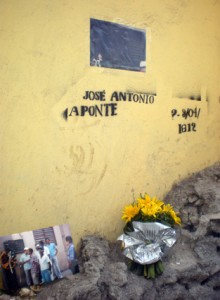
HAVANA TIMES — Last Tuesday, the intersection of Havana’s Monte and Aponte streets was the stage of an extremely unusual incident: a highly mixed crowd of people, convened in this public space, sang the National Anthem and “vandalized” one of the walls of a building. But this story doesn’t start here. We must go some way back in history.
José Antonio Aponte could well have become a key figure in Cuba’s history. A free black man, an artisan and artist, a resident of the (still) humble quarter of Jesús María, located beyond Havana’s city walls, he was the leader of a revolt that sought to do away with slavery and Spanish colonialism at the beginning of the 19th century.
It was the first known independence initiative which became more than a local slave rebellion and involved white sectors of the population. It was a formidable plan which relied on a network of contacts, spread across the island, and envisaged simultaneous uprisings that would destabilize the colonial system, hatched at the time of the first stirrings of Independence in Latin America, when Haiti had proclaimed the abolition of slavery and the establishment of the hemisphere’s first black State.
Informed on by a traitor, Aponte was captured and executed on April 9, 1812, 201 years ago.
A secret society and a mysterious book
A skilled wood sculptor and engraver, Aponte had carved an extremely beautiful sculpture of Jesus Christ which has been lost, but which would later baptize a street in Havana, to this day named Jesús Peregrino.
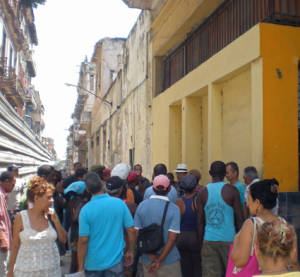
As oral tradition has it, he was a member – an ekobio – of the Abakua secret society and knowledgeable of its elaborate pictograms and secret signals, which dated back to African antiquity.
According to the reports drafted by Spain’s colonial police, Aponte had put together an illustrated volume to educate his followers politically. The book contained skillfully drawn portraits of black men wearing General’s uniforms and symbolic figures which invoked African history, the struggle for freedom, military training and many other images.
The book, similar in its aims to the alchemists’ “wordless” volume (which was also devoid of written text), has also been lost, but different interpretations of its alleged contents have given birth to several works of literary fiction.
Head in a cage
Following his execution, colonial authorities ordered Aponte’s decapitation and publicly exhibited his head inside of a cage. The idea was to make an example of him, for all black people to see.
It was around this time that the popular phrase “meaner than Aponte”, used colloquially in Cuba until recently, came into being.
The location where the cage holding Aponte’s head was placed, the intersection of Belascoaín and Reina streets, is today a busy intersection where one finds a department store, a Jesuit church, Cuba’s National Masonic Temple and a park dedicated to the memory of Karl Marx (very few people know this, and Marx’s head, not Aponte’s, protrudes from the park’s relief mural).
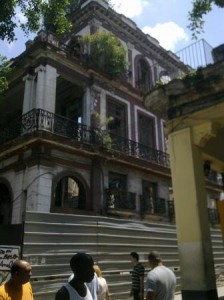
Monumental absence
Cuba’s cultural colonialism and racist prejudices have prevented the erection of a statue or monument in honor of the black leader at this historic site. In 2012, two hundred years after Aponte’s execution, a governmental commission made up of prestigious scholars was supposed to settle this outstanding debt, but bureaucratic hurdles have, to this day, impeded the creation of anything remotely resembling the proposed monument. And, word has it, it was to be an interesting memorial indeed: a statue of a triumphal Aponte, crushing an iron cage, similar to the one that once held his head, under his boot.
Two years ago, during a scientific and cultural symposium organized by Havana’s African Culture Center (Casa de África), a renowned scholar suggested that a fundraiser be held to finance the construction of the monument, a common practice before the Revolution. But the proposal “fizzled out”, as we say in Cuba. So, we have a government commission and no popular participation in the matter…and still no monument to Aponte.
70 years ago, Cuban anti-fascists took issue against a much-too-racist historical memory
As early as the 1940s, however, the efforts of a group of Cuban anti-fascists and Spanish Civil War Republican veterans, individuals who were logically opposed to racism, resulted in the christening of a street in Old Havana with the name of “Aponte”.
In a frequented corner of this street, they installed a memorial plaque with an inscription which read: “TO JOSÉ APONTE AND HIS COMRADES: 1812-1943. ASSOCIATION OF FORMER COMBATANTS AND REVOLUTIONARY ANTI-FASCISTS OF CUBA”. The plaque showed a group of stalwart black men that answered the call of freedom by breaking the heavy chains that bound them.
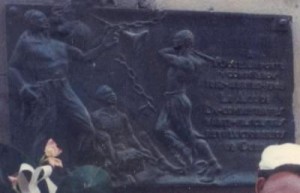
Answers “from below”
On the 9th of April of 1995, the Abakuá Unity Association (Organización de Unidad Abakuá), a Cuban all-male fraternal association centered on ancestral African issues located in San Miguel del Padrón, Havana, organized an homage to Aponte at the location of the plaque.
Activist Tato Quiñones, renowned anti-racist activist, wrote a moving passage for the occasion, in which he quoted the exiled scholar Leví Marrero, for whom Aponte “demonstrated a capacity for organized struggle and personal qualities that even his most violent detractors were forced to acknowledge”.
Havana’s first city historian, Emilio Roig de Leuschenring, called Aponte “an idealistic and generous man, who, spared the horrors of slavery, sought to save his brothers from its scourge”.
Raw materials
During the “Special Period” (the severe economic crisis Cuba in the 90s), someone stole Aponte’s memorial plaque.
It was made of bronze, and that is valuable metal that can be used to produce all manner of products. That, at least, is the most probable hypothesis regarding what happened.
All we are left with is a rather blurred photograph…
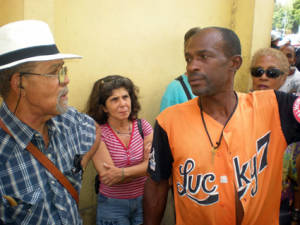
On April 9, 2013, members of the Observatorio Crítico and the Anamuto collective organized a flashmob that convened at the former site of Aponte’s memorial plaque.
On one of the walls, we spray-painted some graffiti, and several activists spoke of Aponte. We pasted a photo of the black leader on the wall and laid down a flower-wreath.
Havana’s former Isla de Cuba Hotel –which once held the original plaque on one of its walls – is undergoing “major restoration”. We were unable to find out whether anyone knew the current whereabouts of the plaque, but neighborhood residents gave us all their support in our efforts to do so.
Those who live on Aponte St. today know very well who the street is named after. “Is it major restoration or capitalist restoration?,” one of the participants asked that day.
Grandfather of the Cuban Nation
“Aponte is the true father of the Cuban nation,” one of the activists said with emotion. “If not its father, at least its grandfather,” another activist added.
In Cuba, the lofty appellation of Father of the Homeland is reserved for Carlos Manuel de Céspedes, an aristocrat born in an eastern province of the island who, in 1868, freed his slaves to set the struggle for independence in motion. Fifty-six years before him, Aponte, already a free man, had tried to organize slaves, both male and female, and the inhabitants of Cuba in general, to free themselves by their own means.
Racism, colonialism, social inequality, marginalization and intolerance towards differences regrettably still exist in Cuba.
Aponte lives. The struggle continues.
Click on the thumbnails below to view all the photos in this gallery. On your PC or laptop, you can use the directional arrows on the keyboard to move within the gallery. On cell phones use the keys on the screen.
















